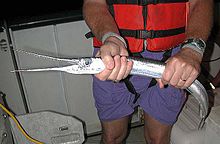
Gars are an ancient group of ray-finned fish in the family Lepisosteidae. They comprise seven living species of fish in two genera that inhabit fresh, brackish, and occasionally marine waters of eastern North America, Central America and Cuba in the Caribbean, though extinct members of the family were more widespread. They are the only surviving members of the Ginglymodi, a clade of fish which first appeared during the Triassic, over 240 million years ago, and are one of only two surviving groups of holosteian fish, alongside the bowfins, which have a similar distribution.
Hemiramphidae is a family of fishes that are commonly called halfbeaks, spipe fish or spipefish. They are a geographically widespread and numerically abundant family of epipelagic fish inhabiting warm waters around the world. The halfbeaks are named for their distinctive jaws, in which the lower jaws are significantly longer than the upper jaws. The similar viviparous halfbeaks have often been included in this family.
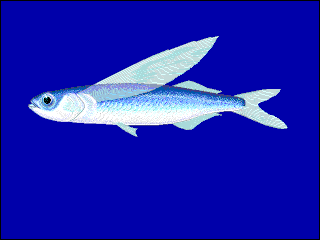
Beloniformes is an order composed of six families of freshwater and marine ray-finned fish:
Sauries are fish of the family Scomberesocidae. There are two genera, each containing two species. The name Scomberesocidae is derived from scomber and the Latin esox meaning pike.
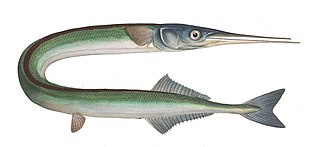
The garfish, also known as the garpike or sea needle, is a pelagic, oceanodromous needlefish found in brackish and marine waters of the Atlantic Ocean and the Mediterranean, Caribbean, Black, and Baltic Seas.
The Atlantic saury is a fish of the family Scomberesocidae found in the North Atlantic Ocean from the Gulf of Saint Lawrence, Canada south to Bermuda and North Carolina in the western Atlantic and from Iceland to Morocco in the eastern Atlantic, it is also found in the Mediterranean Sea, the Adriatic Sea and the Aegean Sea.
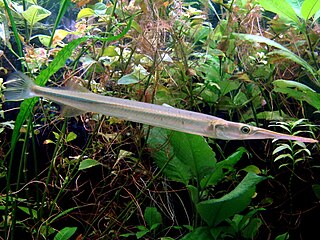
Xenentodon cancila, the freshwater garfish, is a species of needlefish found in freshwater and brackish habitats in South and Southeast Asia.

Xenentodon is a genus of needlefishes native to Asia. It is one of ten genera in the family Belonidae.
Blue-backed fish ; also referred to as Blue-fish is a category of fish used in Japanese cuisine that have a rich and fatty taste, and are distinguished from another category of white meat fish that tend to have a lighter and more delicate flavor. It is not a scientific categorization, but refers to commonness in outer appearance, fleshiness and oiliness and include such species of fish as sardine, mackerel, herring, perch and anchovy. Blue-backed fish tend to be high in the essential amino acid, histidine, as well as the omega-3 fatty acids, eicosapentaenoic acid (EPA) and docosahexaenoic acid (DHA), and are generally said to have health benefits when included in a balanced diet, including such effects as reducing cholesterol.

Belone is a genus of needlefish common in brackish and marine waters. It is one of ten genera in the family Belonidae.
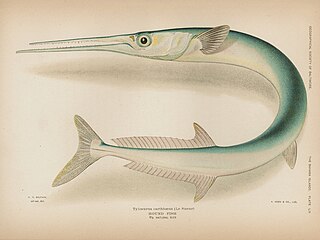
The houndfish is a game fish of the family Belonidae. It is the largest member of its family, growing up to 5 feet (1.5 m) in length and 10 pounds (4.5 kg) in weight. It is also often called the crocodile needlefish.

Strongylura is a genus of needlefishes from the family Belonidae which is distributed throughout the tropical and warmer temperate waters of the world, including some species which live in freshwater.

Tylosurus is a genus of needlefish, one of ten in the family Belonidae. They are found worldwide in tropical and warmer temperate seas and two species have been recorded as Lessepsian migrants in the eastern Mediterranean Sea.
The short-beaked garfish is an uncommon species of needlefish in marine waters of the eastern Atlantic Ocean. This pelagic needlefish is present off the coasts of Ireland, Spain, Portugal, and the United Kingdom, and possibly in the Mediterranean Sea, as well. This species was thought to be the same as the garfish because they share the same waters. The short-beaked garfish matures at 30 cm (12 in) and can grow to a maximum of 65 cm (26 in) while Belone belone can be 95 cm (38 in). Like all needlefish, this one has an elongated body with beak-like jaws that are lined with razor sharp teeth. The short-beaked garfish's lower jaw is longer than the upper. Its body is silvery like most needlefish and has a black stripe running across its lateral line. The dorsal and anal fins are very close to the caudal peduncle. These fish are oviparous. Eggs may be found attached to objects in the water by tendrils on the egg's surface. These spherical eggs are dispersed on the sea floor (demersal). Not much is known about this fish's feeding habits. It likely preys on small oceangoing fish. It has been caught using mackerel. Needlefish tend to be surface fish, so are preyed upon like Atlantic mackerel, European pilchard, sand smelt, etc. The specific name honours Anatolii Nikolaevich Svetovidov (1903-1985) who was an ichthyologist at the Zoological Institute in Saint Petersburg, Russia and a colleague of N.V. Parin.
Belonion dibranchodon is one of two needlefish, in the genus Belonion, which is in the family Belonidae in the order Beloniformes. They are native to South America within the Atabapo and Negro River basins, and can be found in freshwater environments within a benthopelagic range in a tropical climate. B. dibranchodon can reach about 4.8 cm (1.8 in) in length. This species is recorded to be oviparous; they produce their young by means of eggs. The eggs can be found on objects in the water attached by tendrils on the surface of the egg.

Various marine animals are capable of aerial locomotion, i.e., jumping out of the water and moving through air. Some possible reasons for this behavior are hunting, escaping from predators, and saving energy for swimming or breathing. Some of the jumping behaviors initiate gliding and taxiing in air, while some of them end up falling back to water.

Tylosurus choram, the Red Sea houndfish, is a species of needlefish from the family Belonidae. A marine fish bluish in color with a long slender body, and a pointed long toothed beak, found in most temperate, warm seas, and sometimes rivers, it is found in abundance in the Red Sea. It is a fast predator swimming in small schools near the water surface. Like other species of needlefish this species is oviparous, laying eggs which attach themselves to objects in the water by means of filaments which cover the outer layer of the egg. Tylosurus choram is found in the Red Sea and in coastal waters around the Arabian Peninsula to the Gulf of Oman. It has been reported twice, forty years apart, in the Mediterranean Sea off Israel. This species was described as Belone choram by Eduard Rüppell in 1837 with the type locality given as the Red Sea, the specific name choram is Arabic for needlefish.
The long tom or freshwater longtom is a species of euryhaline needlefish native to Northern Australia and Papua New Guinea.: This species occurs in the coastal rivers of tropical Australia and New Guinea. In Australia it has been recorded from the Fitzroy River in Western Australia to the Dawson River in Queensland. It is found in areas of still or flowing water in larger rivers from the tidal reaches to far inland and adults are infrequently recorded in coastal marine waters. Preferred habitats include river channels, floodplain lagoons, muddy creeks and billabongs where it often shelters below overhanging vegetation or among submerged roots. It is a nocturnal hunter of small fishes, crustaceans and insects with the adults being almost exclusively piscivorous, ambushing their prey from cover. Strongylura krefftii was described as Belone krefftii by Albert Günther in 1866 with the type locality given as "Australia ". The specific name honours the Australian zoologist Gerard Krefft (1830-1881) who presented Günther with the type.
Platybelone lovii is a species of needlefish from the family Belonidae. It is a predatory, pelagic fish which is endemic to the eastern Atlantic Ocean in the waters around Cape Verde. This species was described by Albert Günther in 1866 as Belone lovii and was named in honour of the British naturalist Richard Thomas Lowe (1802-1874).
Strongylura strongylura, the spottail needlefish or blackspot longtom, is a species of needlefish from the family Belonidae. It is found in the Indian and western Pacific Oceans from the Persian Gulf east to Australia and the Philippines. This species occurs in coastal waters and in mangrove-lined lagoons as well as being recorded in estuarine areas and it has even entered freshwater. Living S. strongylura have been found alive and buried in mud during low tide. It is piscivorous, feeding mainly on clupeoids. This species is oviparous and the eggs adhere to objects in the water which catch the tendrils which cover the surface of the egg. Strongylura strongylura under the synonym of Strongylura caudimaculata is the type species of the genus Strongylura. It as originally described as Belone strongylura by Johan Coenraad van Hasselt in 1823 with the type locality given as Vizagapatam, India.
